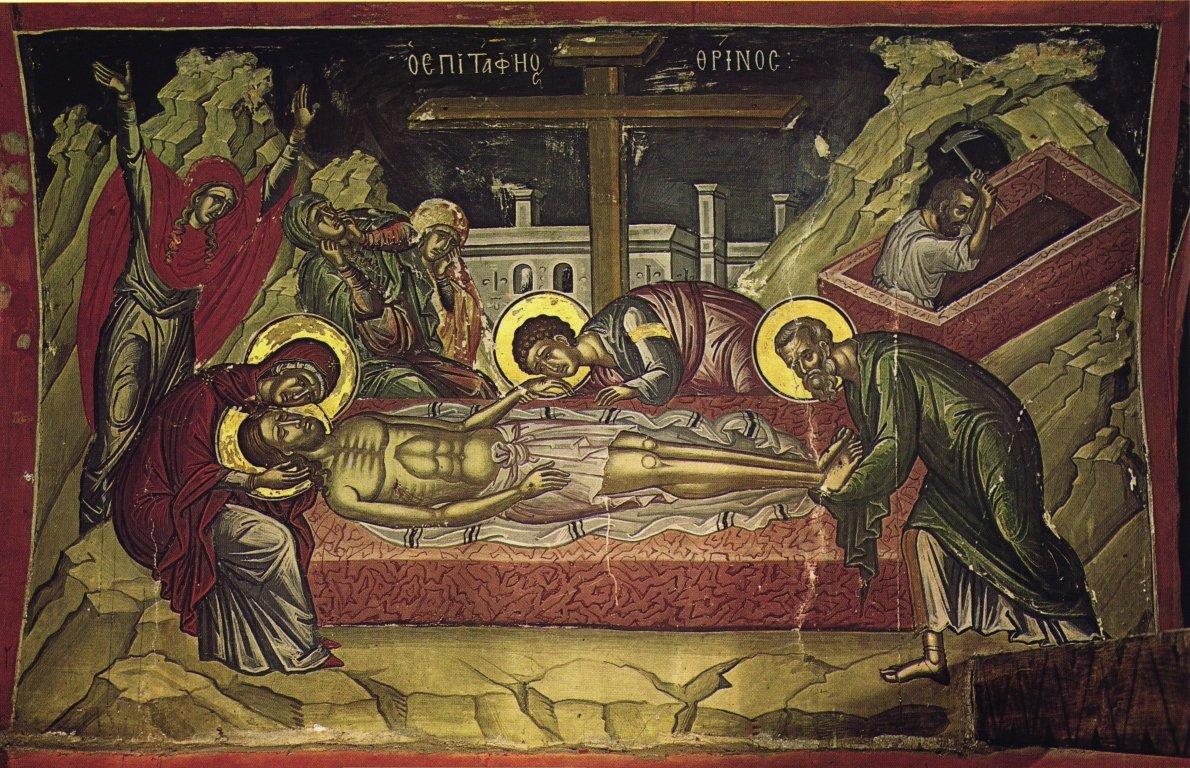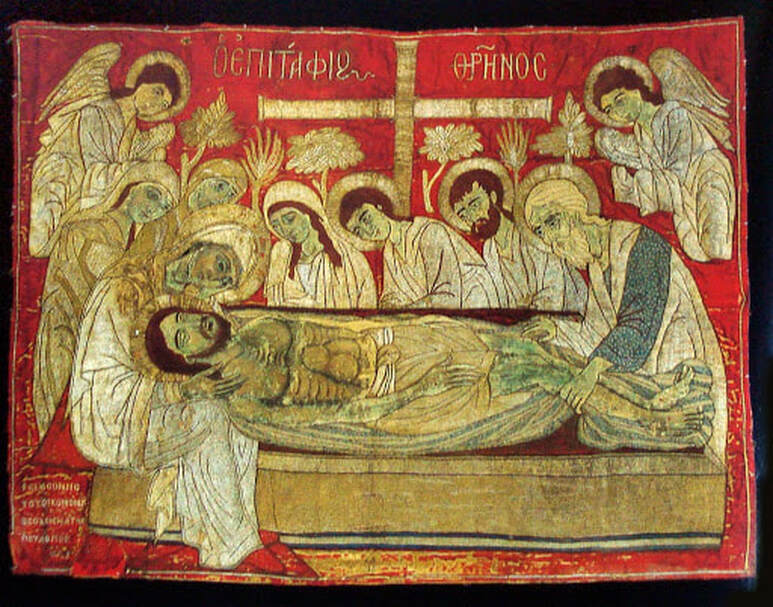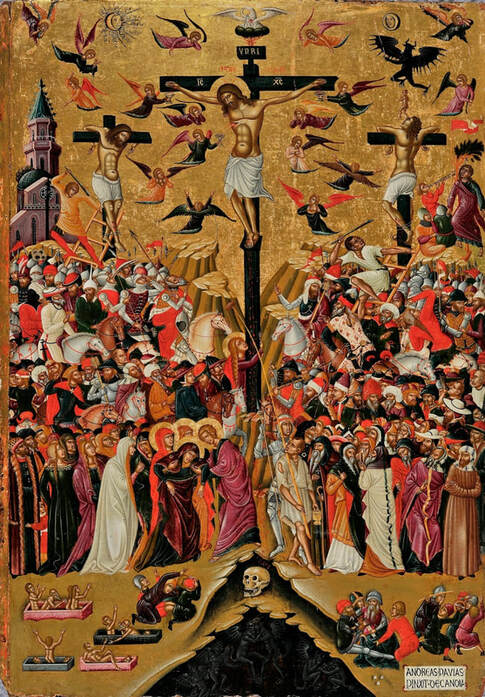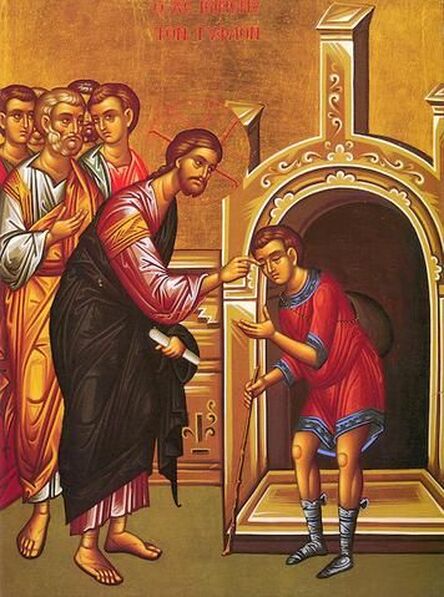|
Themes: Victory over death, praise of our God Who alone does wondrous things, and the universality of the Gospel
Gospel Reading: John 20:19-25 Sometime late on Easter Sunday morning or in the afternoon hours, we celebrate the Vespers of Pascha, also known as the Agape service. It is a Great Vespers service centered upon the message of Pascha – the risen Jesus Christ. All the hymns give glory to God for His resurrection from the dead, for freeing us from the curse of the ancient law – death, and for restoring mankind (and indeed the entire world) to its former position – communion and union with God.
This service starts off with a Vespers and then moves into the Liturgy of St. Basil. During the Vespers, a
number of prophecies from the Old Testament are read. After the prophecies, the Divine Liturgy of St. Basil begins. After the epistle reading, the priest scatters bay leaves around the church as a sign of Christ’s victory over death. After that, the lesson from the gospel is read and the Liturgy continues as usual. Theme: Christ’s resurrection Prophecies: Genesis 1:1-13, Jonah, Daniel 3:1-57 (including the Hymn of the Three Youths); Epistle: Romans 6:3-11, Gospel: Matthew 28:1-20 All of the hymns during this service are paschal, or resurrectional, in nature. We have eagerly awaited the moment of His resurrection, and during this service, we get a foretaste of the tremendous joy of that moment. The odd thing is that this is done so early on Saturday. This is because this Liturgy used to be a part of a long Paschal vigil that started late in the afternoon and which lasted towards midnight. Now, however, the service has been pushed back to the morning. So even though the hymns and Gospel Lesson describe the resurrection, we still have to wait until midnight before we can truly celebrate it.
Good Friday afternoon - Apokathelosis
This is the Vespers of Good Friday. It is also called the Apokathelosis – or “unnailing from the cross.” We remember that at this time, Christ “gave up His Spirit.” During the service, the icon of Christ is taken down from the cross and wrapped in a white cloth, which symbolizes His burial garment. The icon of the body is taken into the altar and remains there until after the Feast of the Ascension. This is symbolic because the altar, in particular the Altar Table/Holy Table, is symbolically the tomb of Christ. What comes from the tomb of Christ? Life and the Risen Lord. What comes from the Altar? Life and the Risen Lord in the Holy Communion that is prepared and of which we can partake. As Christ came forth from the tomb giving Life, so does the priest come forth from the altar and offer life when he says, “with the fear of God, faith and love draw near” as he brings forward the Holy Communion for the people. Also, the priest processes with the Epitaphion. The Epitaphion is the icon that is placed in the beautifully decorated wooden tomb. The Epitaphion is not the wooden tomb that is decorated with all of the flowers – that is called the kouvouklion. The priest places the Epitaphion in the kouvouklion at the end of the procession. Theme: salvation granted to us through His “awful Passion, the Cross, and condescension to voluntary entombment in the flesh.
Themes: The Mystical (Last) Supper; Jesus washing the feet of the Disciples, the Garden of Gethsemane
Gospel Reading: Matthew 26:2-20, John 13:3-17, Matthew 26:21-39, Luke 22:43-45, Matthew 26:40 – 27:2 Remember, even though this service takes place in the morning, it is really part of a Great Vespers service for Thursday evening. The Mystical Supper took place in the evening on a Thursday. Today, we remember Mystical Supper on Thursday, but in the morning instead of in the evening.
*(Sung on Tuesday night)
Themes: The faithful woman who anointed the head of Jesus with costly, fragrant oil; the selfishness and greed of Judas; Jesus as a suffering servant. Gospel Reading: John 12:17-50 Beloved Brothers and Sisters in Christ, On this day, we remember the woman who used very expensive oil to anoint the head of Jesus (Mt. 26:6-13). Christ says that she did this “For in pouring this fragrant oil on My body, she did it for My burial.” This was done shortly before Jesus’ passion, or just before He was to suffer for all of mankind. Christ even says, “Assuredly, I say to you, wherever this gospel is preached in the whole world, what this woman has done will also be told as a memorial to her.” Of course, these words are true today. Throughout the world, her gift to Christ has been made known. In fact, on Tuesday night, we hear the Hymn of Kassiani, which describes this selfless act of love towards our Lord and Savior Jesus Christ. Even the disciples thought the money she used on the oil would be better used if given to the poor. But Jesus says she did a great thing because we will always have a chance to help the poor around us, but we may not always get the chance of helping Christ Himself. |
AuthorsMessages written by the clergy of our parish. Archives
May 2021
Categories
All
|
© 2023
Saint Nicholas Greek Orthodox Church
3109 Scio Church Road, Ann Arbor, MI 48103
Phone: (734) 332-8200
Fax: (734) 332-8201
Saint Nicholas Greek Orthodox Church
3109 Scio Church Road, Ann Arbor, MI 48103
Phone: (734) 332-8200
Fax: (734) 332-8201










 RSS Feed
RSS Feed
